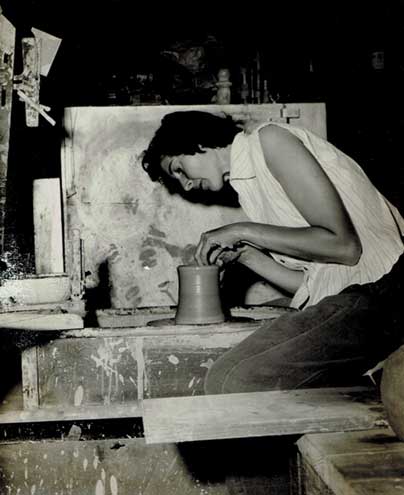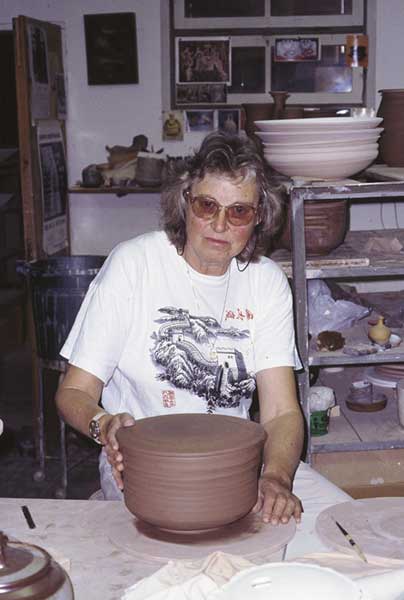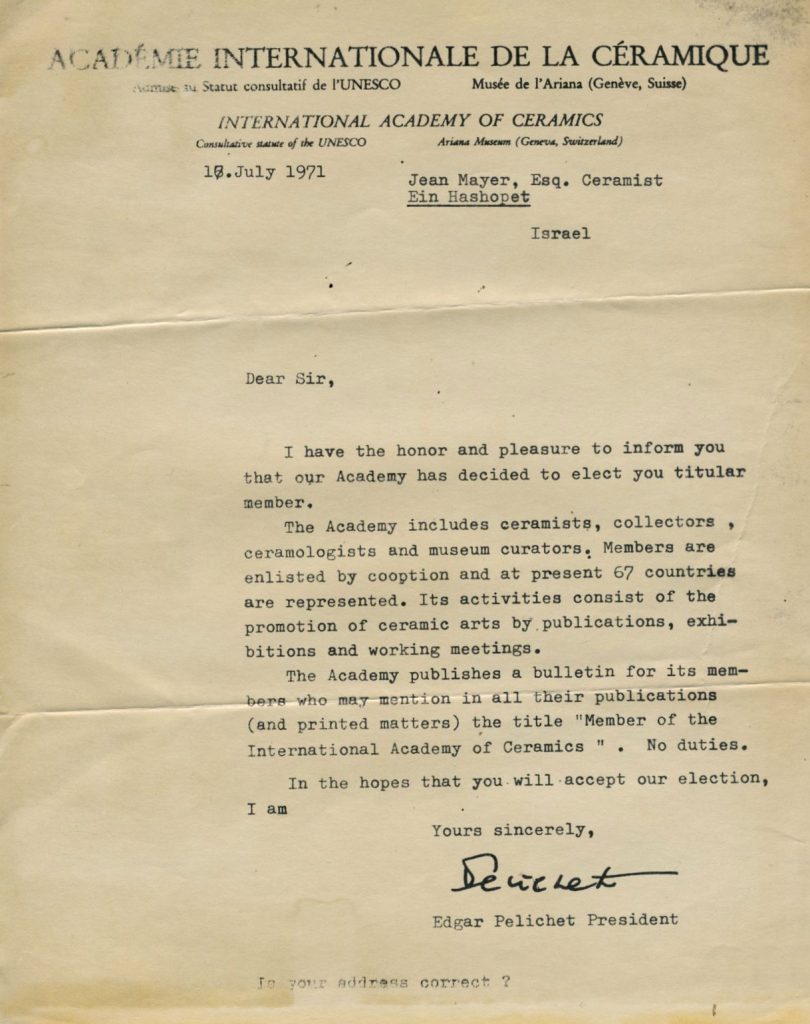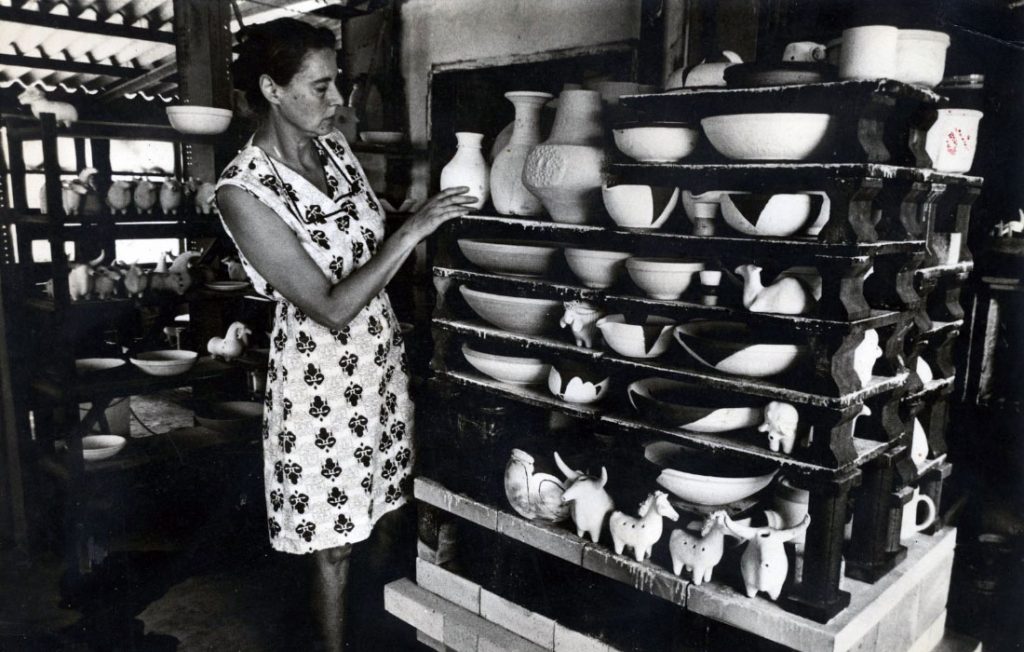About
the Artist

Jean Mayer, 1924-2000
Jean Davis Meir was born in London, England.
From 1945-1948 she studied art at Chelsea School of Art and worked in a theater setting.
1950-1951-she studied ceramics at Camberwell School of Art.
Jean married Alex Mayer, and together they immigrated to Israel in 1951 as part of the core group of new immigrants who joined Kibbutz Ein-HaShofet in the Menashe Hills. Jean brought with her a kiln, a potter’s wheel and much idealism.
Following the establishment of the state of Israel, the country was under austerity. As a kibbutz member, Jean worked in the vegetable garden, the orchard, the vineyard and the kitchen. Only in the leisure hours was she able to devote herself to her passion, ceramics. She set up her first studio in a tent, and the potter’s wheel stood outside.
Some of the works that were prepared for firing were taken to Hana Harag-Zuntz in Haifa, when Jean traveled to her to learn about materials and techniques used in Israel.
From 1954 until 1969, Jean taught ceramics, painting and art history at the Harei-Efraim Regional High School.

Jean Mayer, 50's
In 1956, she was provided a building that became her studio, and the kiln was also activated. The kibbutz recognized her artistic abilities and allowed her to work in the studio as part of her workday. For the first few years, Jean fired material at a temperature of up to 1100 degrees to make Earthenware pottery. In 1959, she began to use Stoneware clay (Limescale), which burns at a temperature of 1200 degrees. The gas kiln was purchased in 1969. The gas fire reached a temperature of up to 1260 degrees. At that temperature, the reduction technique causes the colors of the glazes to change. (These brilliant colorings and effects are created when metallic oxides in glazes change form https://www.thesprucecrafts.com/how-to-fire-in-reduction-2745938)
The potter’s skill in this procedure requires extensive experience and knowledge. Jean’s ability to use different glazes, and to place the items appropriately in the kiln, enabled her to control the results. Sometimes there were failures, and at other times there were amazingly beautiful surprises.
After a series of attempts, Jean succeeded in composing a form of clay, which suited her ability and creative perception. This unique clay named “Jean” became well known and was produced by leading clay manufacturers who also sold it to other ceramicists.
At the beginning of Jean’s career as a ceramicist, the use of the paint-Glazora appeared more often as an illustration, which was a continuation of her study of painting. In her work, she quickly learned the use of both glazing and the functional and aesthetic importance of the pottery. Her control and understanding of chemistry allowed her to develop a unique variety of colors that gave an additional facet to her work.

Jean in her Studio, 1999
In the late 1960’s, Jean was asked by Professor Abraham Kampf to establish a ceramics department in the art department of Haifa University, where she taught for seven years (1970-1975 1987-1988).
In 1971 she was accepted as a member of the International Academy of Ceramics.
From 1975 to 1995, she taught ceramics at the cathedra for adult students at the Megiddo Regional Council. With the passing of years, ceramics became her fulltime work. A huge variety of pottery was produced: mugs and sets of tableware, a variety of bowls, bottles and jars. Large handmade compositions were also produced such as practical sculptures and exterior sculpting, as well as wall reliefs.
For Jean, it was important that her profession as an artist is as profitable as any other occupation in the kibbutz. However, in 1985, on reaching retirement age, she felt free to produce sculptures and build large bowls, pots and vessels. She also began to work with porcelain, which is more suitable for delicate ceramics and miniature sculpture.
As a rule, Jean put aside from each firing, a selection of pieces she considered outstanding. Consequently, a rare collection of dozens of beautiful items were preserved, which later became the source for her to plan a retrospective exhibition to acknowledge and showcase fifty years of creativity. Jean was able to begin the preparation for that exhibition, but could not complete it. After her demise, it was exhibited at the Wilfred Museum in Kibbutz Hazorea, at the Mane-Katz Museum in Haifa, and at the Beit Aharon Kahana Museum in Ramat Gan.
Today, this diverse and unique collection is preserved and presented in Jean’s studio, which was renovated for that purpose.
Jean has been recognized as one of the most senior Israeli pottery artists in Israel, because of the professionalism and quality of work she created. The studio, in Ein-Hashofet, became, over the years a well-known place to visit for potters and ceramic lovers from Israel and the world. A large amount of Jean’s work, including decorative walls and environmental sculpting, can be found in Israel and abroad.
Jean died of cancer in August 2000.


